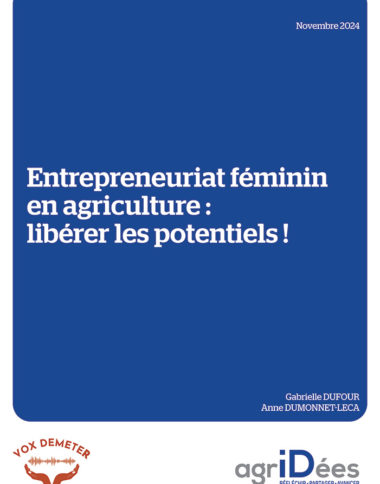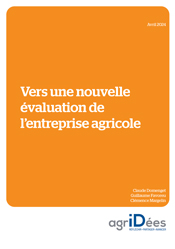Notes
Temps de lecture : 3 min
07/04/2025
A land-based bioeconomy, enabling farming resilience

These reflections are part of a European momentum for the bioeconomy. Indeed, a new European strategy has been announced by the end of 2025 in the new European Commission’s “Compass for Competitiveness”. In addition, the December 2024 Agriculture and Fisheries Council highlighted “the important role of the sustainable and circular bioeconomy in addressing current
challenges and support the Union’s economy, in particular by creating essential jobs and increasing competitiveness”. The bioeconomy is therefore a solution for decarbonization and
sovereignty.
Résumé
Some players in the farming world (farmers, agri-food and agro-industry companies, interbranch organizations) have been involved in the bioeconomy (biobased economy) for several decades. Successful industry projects have demonstrated the complementarity and interdependence of food and non-food uses for agricultural biomass. Biorefineries (as synergies between agriculture and industry) have been set up, often with the help of major investments by the farming community, and cooperatives in particular. Biofuels (biodiesel and bioethanol) are examples of structured value chains, combining food and feed uses with bioenergy. More recently, agricultural digesters have developed as small biorefineries in “local supply chains”, directly involving farmers in biogas production and with a circular dimension of returning the digestate to the soil.
Building on these experiences, players in the agricultural world, and farmers in particular, now need to strengthen and diversify their participation in the circular and territorial bioeconomy, to address the challenges that are accumulating. It is not only a question of food security and sovereignty, but also of energy and industry sovereignty in the context of geopolitical instability, decarbonization of the economy to tackle climate change, the challenge ok making professions attractive as the farming community declines, and losing meaningful work, questioned by the society.
A successful “bioeconomic transition” is therefore possible, but only under a number of conditions. Firstly, public incentives need to be more consistent with one another and with biomass availability. Incentives for the production and consumption of biomaterials and biobased molecules need to be strengthened, for example by highlighting the intrinsic properties provided by local agricultural biomass, and by informing consumers of these characteristics. In addition, research and development must be stepped up in terms of technological and functional innovation, to make biobased products more competitive with oil-based products. Secondly, the demand for agricultural biomass is strong to decarbonize the economy as a whole and we will have to assume to increase the production of biomass identified as a priority, under certain conditions and in certain areas. For example, we need to give preference to productive crops with multiple uses (food and non-food) on fertile land, in order to respond simultaneously to several strategic challenges (food and industrial sovereignty in particular).
Farmers need to consider the bio-economic transition as a business strategy, elaborated with the relevant economic, financial, legal and human support, and in line with the local agronomic, soil, climatic industrial and geographical specificities. As a catchment area, it must have a local industrial demand (biorefinery) for processing and a societal demand (urban district) for at least part of the final consumption of biobased products, materials or energy. In addition, it is not just the processing of agricultural biomass that should generate value for farmers, through collective initiatives, but also the ecosystem services provided by virtuous production practices, if they are recognized as such because they are quantified with validated methods (Payments for Environmental Services, carbon credits, regenerative agriculture premiums, etc.). The compass farm managers need to help them make choices will have to be based on a decision-making tool made up of financial and extra-financial accounting indicators. This tool will be particularly useful in the context of the implementation of the European Corporate Sustainability Reporting Directive (CSRD). The multiperformance of farm businesses engaged in a circular and territorial bioeconomy can be a source of resilience, under these conditions.
Nos propositions
1. Producing local references to help policy makers and economic stakeholders shape decisions:
- Preparing an inventory of feedstock supply and demand as well as industrial processing facilities in local areas, using EU-harmonized methods;
- Setting up an observatory of actions monetizing sustainable agricultural practices for farmers and monitoring these data;
- Encouraging research into new methodologies for assessing the positive externalities of biobased products, enabling the creation of multi-criteria comparison tools for environmental, economic and social impacts.
2. Increasing overall biomass production to meet multiple demands:
- Facilitate the deployment of incentive financing tools (Payments for Environmental Services, “agricultural transition” tax credit, research tax credit, carbon and biodiversity credits, regenerative agriculture-type premiums…) that monetize the co-benefits of bio-based products.
- In the event of a decline in livestock production as a result of the rise in flexitarianism, providing farmers with strategic guidance on the impact of converting to the production of non-food goods and services, based on a sectoral and regional approach;
- Prioritizing the production of biomass with multiple markets (both food and non-food), paying particular attention to the sharing of value between the different links in the supply chain, as a price-risk management tool for farmers.
3. Prioritizing initiatives that make sense locally:
- Building a decision-making tool for economic players in agricultural ecosystem territories, based on a multi-criteria radar aimed at resilience, as part of a Territorial Bioeconomic Project, along the lines of the Territorial Food Projects (PAT);
- Making biomass production incentives conditional on the presence of a territorial biorefinerytype biomass valorization industrial tool, as part of a sector development rationale;
- Posting a development plan for agricultural biorefineries, encouraging new industrial players to set up on pre-existing platforms in line with local agricultural biomass production;
- Broadening the analysis of industrial projects by regional biomass units to take into account not only supply plans in terms of volumes, but also impacts in terms of value creation;
- Promoting the deployment of socio-environmental accounting (CARE method) for farms, considering their own carbon footprint and commitment to decarbonizing the economy. Supporting actions already underway.
4. Making public incentives more consistent and balanced:
- Moving away from the polarized vision of food/non-food production, which are intimately linked, by making public policies more consistent, with a holistic vision;
- Strengthening incentives for biomaterials and biobased chemistry (currently lower than incentives for bioenergy), based on the intrinsic and differentiating properties of these products (quality, durability, naturality).
5. Enhancing the visibility of actions undertaken:
- Raising awareness among agricultural and industrial players through local forums (regional bioeconomy forums, trade shows, Paris International Agricultural Show);
- Raising consumer awareness with “clean labels” (European Product Environmental Footprint, national environmental labelling) that take better account of sustainable agricultural practices and the biogenic carbon composition of products.










